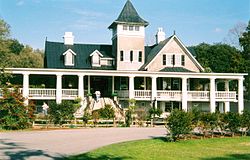Magnolia Plantation and Gardens | |
 Plantation home at Magnolia Plantation | |
| Nearest city | Charleston, South Carolina |
|---|---|
| Coordinates | 32°52′35″N 80°05′01″W / 32.87651°N 80.08351°W |
| Area | 390 acres (160 ha) |
| Built | 1850 |
| NRHP reference No. | 72001198[1] |
| Added to NRHP | December 11, 1972 |





Magnolia Plantation and Gardens (464 acres, 187.77 hectares) is a historic house with gardens located on the Ashley River at 3550 Ashley River Road west of Ashley, Charleston County, South Carolina.[2][3] It is one of the oldest plantations in the South, and listed on the National Register of Historic Places. Magnolia Plantation is located near Charleston and directly across the Ashley River from North Charleston. The house and gardens are open daily; an admission fee is charged.
The plantation dates to 1679, when Thomas and Ann Drayton (née Anna Fox) built a house and small formal garden on the site. The plantation still remains under the control of the Drayton family after 15 generations.[citation needed] Some of the enslaved people who were forced to work at the house were brought by the Draytons from Barbados in the 1670s.[4] The historic Drayton Hall was built in 1738 by enslaved laborers for John Drayton, grandfather of judge John Drayton II, on an adjoining property.
Magnolia was originally a rice plantation, with extensive earthworks of dams and dikes built in fields along the river for irrigating land for rice cultivation. African enslaved people from rice-growing regions created the works. As time went on, these enslaved people developed a creolized Gullah language and vibrant culture, strongly influenced by their West African cultures.[4] They have retained many combined cultural elements from West Africa to this day in what is known as the Gullah Heritage Corridor of the Lowcountry and Sea Islands of the Carolinas and Georgia.
- ^ "National Register Information System". National Register of Historic Places. National Park Service. July 9, 2010.
- ^ Bull, Elias B.; Bernard Kearse. "Magnolia Plantation and Gardens" (PDF). National Register of Historic Places - Nomination and Inventory. Retrieved June 10, 2012.
- ^ "Magnolia Plantation and Gardens, Charleston County (S.C. Hwy. 61, Charleston vicinity)". National Register Properties in South Carolina. South Carolina Department of Archives and History. Retrieved June 10, 2012.
- ^ a b Rosengarten, Dale. "Drayton Hall Towards Truth and Reconciliation". Drayton Hall official website.

